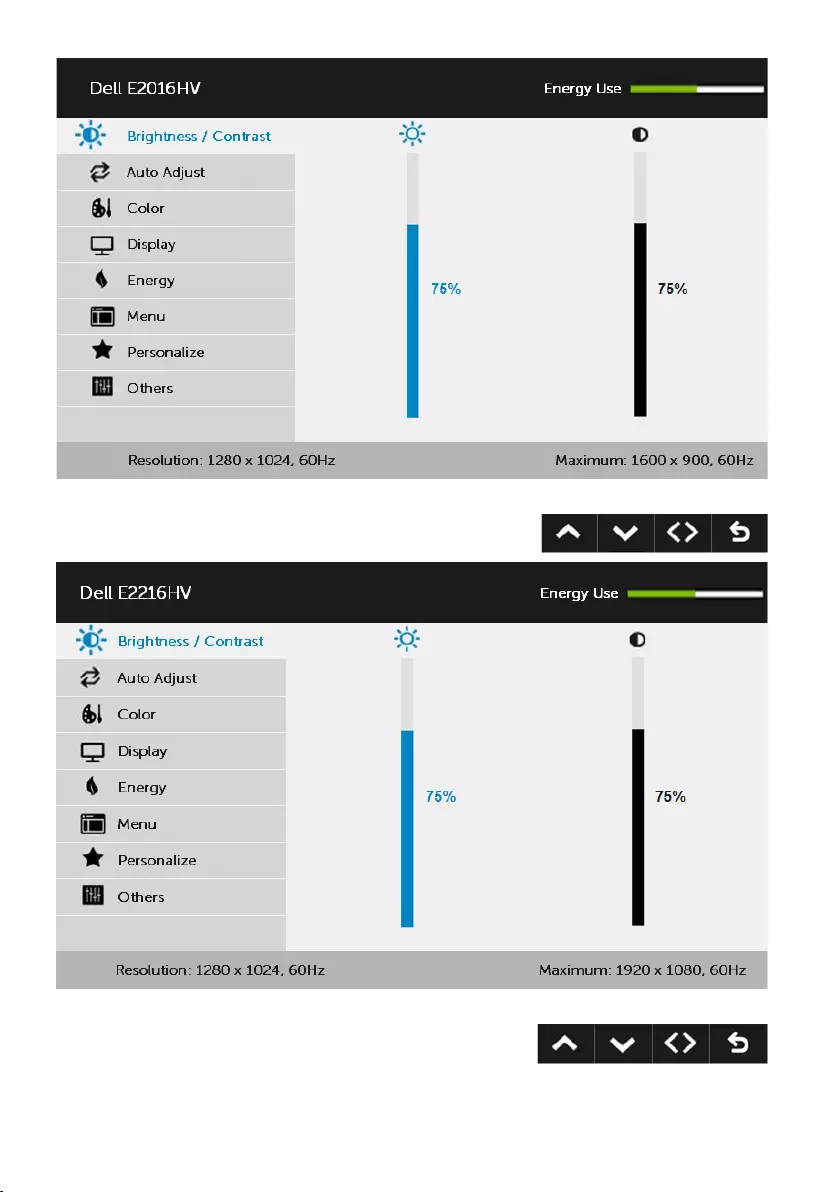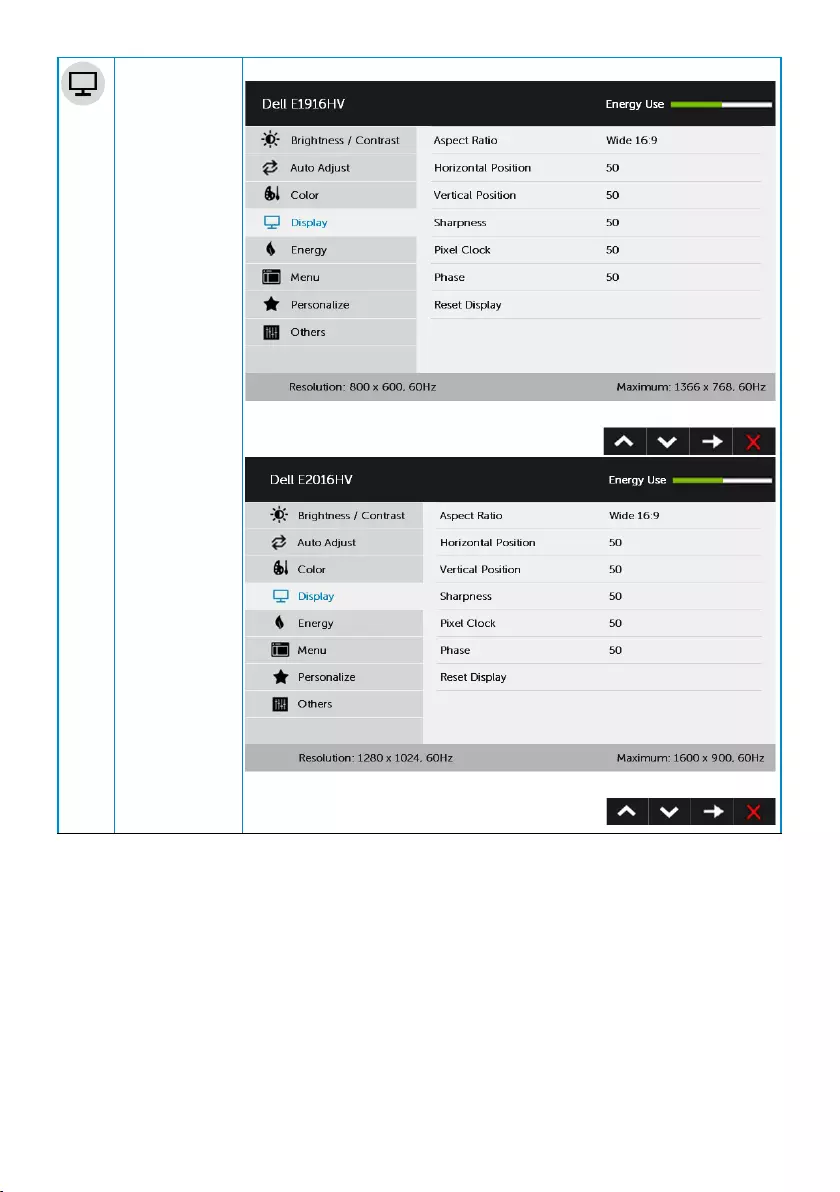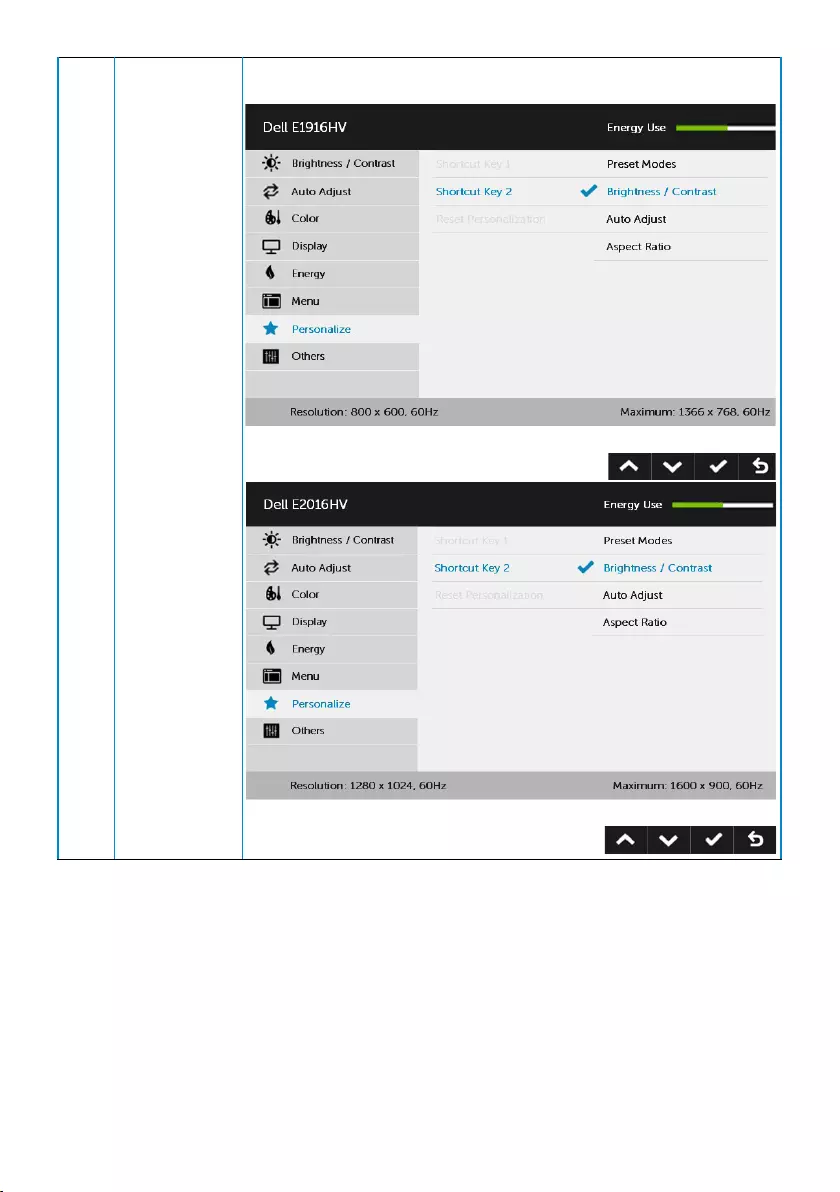Table of Contents
DELL E2216HV User Manual
Displayed below is the user manual for E2216HV by DELL which is a product in the Computer Monitors category. This manual has pages.
Related Manuals

Regulatory model: E1916HVf / E2016HVf / E2216HVf
User‘s Guide
Dell E1916HV
Dell E2016HV
Dell E2216HV

2
NOTE: A NOTE indicates important information that helps you make better use of
your computer.
CAUTION: A CAUTION indicates potential damage to hardware or loss of data if
instructions are not followed.
WARNING: A WARNING indicates a potential for property damage, personal
injury, or death.
© 2015 Dell Inc. All rights reserved.
Information in this document is subject to change without notice. Reproduction of these materials
in any manner whatsoever without the written permission of Dell Inc. is strictly forbidden.
Trademarks used in this text: Dell™ and the DELL logo are trademarks of Dell Inc.; Microsoft®,
Windows®, and the Windows start button logo are either trademarks or registered trademarks of
Microsoft Corporation in the United States and/or other countries.
Other trademarks and trade names may be used in this document to refer to either the entities
claiming the marks and names or their products. DellInc. disclaims any proprietary interest in
trademarks and trade names other than its own.
2015 – 06 Rev. A00

3
Contents
About Your Monitor ..................................... 5
Package Contents . . . . . . . . . . . . . . . . . . . . . . . . . . . . . . . .5
Product Features . . . . . . . . . . . . . . . . . . . . . . . . . . . . . . . . 6
Identifying Parts and Controls . . . . . . . . . . . . . . . . . . . . . . . . . 7
Monitor Specifications . . . . . . . . . . . . . . . . . . . . . . . . . . . . . 9
Plug and Play Capability . . . . . . . . . . . . . . . . . . . . . . . . . . . 12
LCD Monitor Quality & Pixel Policy . . . . . . . . . . . . . . . . . . . . . 16
Maintenance Guidelines . . . . . . . . . . . . . . . . . . . . . . . . . . . 17
Setting Up the Monitor.................................. 18
Attaching the Stand . . . . . . . . . . . . . . . . . . . . . . . . . . . . . . 18
Connecting Your Monitor . . . . . . . . . . . . . . . . . . . . . . . . . . 19
Organizing Your Cables . . . . . . . . . . . . . . . . . . . . . . . . . . . 19
Removing the Monitor Stand . . . . . . . . . . . . . . . . . . . . . . . . 20
Wall Mounting (Optional). . . . . . . . . . . . . . . . . . . . . . . . . . . 21
Operating the Monitor .................................. 22
Power On the Monitor . . . . . . . . . . . . . . . . . . . . . . . . . . . . 22
Using the Front-Panel Controls . . . . . . . . . . . . . . . . . . . . . . . 22
Using the On-Screen Display (OSD) Menu. . . . . . . . . . . . . . . . . 23
Setting the Maximum Resolution . . . . . . . . . . . . . . . . . . . . . . 46
Using the Tilt . . . . . . . . . . . . . . . . . . . . . . . . . . . . . . . . . . 47

4
Troubleshooting .......................................48
Self-Test . . . . . . . . . . . . . . . . . . . . . . . . . . . . . . . . . . . . . 48
Built-in Diagnostics . . . . . . . . . . . . . . . . . . . . . . . . . . . . . . 49
Common Problems . . . . . . . . . . . . . . . . . . . . . . . . . . . . . . 50
Product-Specific Problems. . . . . . . . . . . . . . . . . . . . . . . . . . 53
Dell Soundbar Problems . . . . . . . . . . . . . . . . . . . . . . . . . . . 55
Appendix .............................................. 57
Safety Instructions . . . . . . . . . . . . . . . . . . . . . . . . . . . . . . . 57
FCC Notices (U.S. Only) and Other Regulatory Information . . . . . . 57
Contact Dell. . . . . . . . . . . . . . . . . . . . . . . . . . . . . . . . . . . 57
Setting the display resolution to 1366 x 768 (for E1916HV) or 1600 x 900
(for E2016HV) or 1920 x 1080 (for E2216HV) (Maximum). . . . . . . . 58
Procedures for setting up dual monitors . . . . . . . . . . . . . . . . . 60
Setting Display Styles For Multiple Monitor . . . . . . . . . . . . . . . . 66

About Your Monitor 5
About Your Monitor
Package Contents
Your monitor ships with all the components shown below. Ensure that you have
received all the components and Contact Dell if anything is missing.
NOTE: Some items may be optional and may not ship with your monitor. Some
features or media may not be available in certain countries.
•Monitor
•Stand Riser
•Stand Base
•VESA™ Screw Cover
•Power Cable (varies with countries)
•VGA Cable
•Drivers and Documentation media
•Quick Setup Guide
•Safety and Regulatory Information

6 About Your Monitor
Product Features
The Dell E1916HV / E2016HV / E2216HV flat-panel display has an active matrix, Thin-
Film Transistor, Liquid Crystal Display and LED backlight. The monitor’s features include:
• E1916HV : 47.01 cm (18.51 inches) diagonal viewable image size, 1366 x 768
resolution, plus full-screen support for lower resolutions.
• E2016HV: 49.53cm (19.5 inches) diagonal viewable image size,
1600 x 900 resolution, plus full-screen support for lower resolutions.
• E2216HV: 54.69 cm (21.53 inches) diagonal viewable image size,
1920 x 1080 resolution, plus full-screen support for lower resolutions.
• Tilt adjustment capability.
• Removable pedestal and Video Electronics Standards Association (VESA) 100 mm
mounting holes for flexible mounting solutions.
• Plug and play capability if supported by your system.
• On-Screen Display (OSD) adjustments for ease of set-up and screen optimization.
• Software and documentation media which includes an information file (INF), Image
Color Matching File (ICM), and product documentation.
• Dell Display Manager Software
• ENERGY STAR-compliant.
• Security lock slot.
• Asset Management Capability.
• EPEAT Sliver compliant.
• CECP (for China).
• RoHS compliant.
• Energy Gauge shows the energy level being consumed by the monitor in real time.
• Analog backlight dimming control for flicker free display.

8 About Your Monitor
E2216HV:
Back View with Monitor Stand
Label Description Use
1 VESA mounting holes (100
mm)
To mount the monitor.
2 Regulatory rating label Lists the regulatory approvals.
3 Barcode serial number label Refer to this label if you need to contact
Dell for technical support.
4 Security lock slot Secures monitor with security lock
(security lock not included).
5 Cable management slot Use to organize cables by placing them
through the slot.
Side View
Right Side

About Your Monitor 9
Bottom View
Label Description Use
1 AC power connector To connect the monitor power cable.
2 VGA connector To connect your computer to the monitor using
a VGA cable.
3 Dell soundbar
mounting slots
To attach the optional Dell Soundbar.
Monitor Specifications
The following sections give you information about the various power management
modes and pin assignments for the various connectors of your monitor.
Power Management Modes
If you have VESA’s DPM compliance display card or software installed in your PC, the
monitor automatically reduces its power consumption when not in use. This is referred
to as Power Save Mode. If the computer detects input from keyboard, mouse, or other
input devices, the monitor automatically resumes functioning. The following table
shows the power consumption and signaling of this automatic power-saving feature:
E1916HV:
VESA Modes Horizontal
Sync
Vertical
Sync Video Power
Indicator
Power
Consumption
Normal operation Active Active Active White 17 W (Maximum)**
14 W (Typical)
Active-off mode Inactive Inactive Blank Glowing
white
Less than 0.3 W
Switch off - - Off Less than 0.3 W *
Energy Star Power Consumption
On Mode 13.3 W***
E2016HV:
VESA Modes Horizontal
Sync
Vertical
Sync Video Power
Indicator
Power
Consumption
Normal operation Active Active Active White 17 W (Maximum)**
14 W (Typical)
Active-off mode Inactive Inactive Blank Glowing
white
Less than 0.3 W
Switch off - - Off Less than 0.3 W *

10 About Your Monitor
Energy Star Power Consumption
On Mode 13.4 W***
E2216HV:
VESA Modes Horizontal
Sync
Vertical
Sync Video Power
Indicator
Power
Consumption
Normal operation Active Active Active White 24 W (Maximum)**
18 W (Typical)
Active-off mode Inactive Inactive Blank Glowing
white
Less than 0.3 W
Switch off - - Off Less than 0.3 W *
Energy Star Power Consumption
On Mode 18.2 W***
The OSD will only function in the normal operation mode. When any button except
power button is pressed in Active-off mode, the following messages will be displayed:
Activate the computer and monitor to gain access to the OSD.
NOTE: The Dell E1916HV / E2016HV / E2216HV monitor is ENERGY STAR®-
compliant.
* Zero-power consumption in OFF mode can only be achieved by disconnecting the
main cable from the monitor.
** Maximum power consumption with max luminance and contrast.
*** Energy consumption (On Mode) is tested at 230 Volts / 50 Hz.
This document is informational only and reflects laboratory performance. Your
product may perform differently, depending on the software, components and
peripherals you ordered and shall have no obligation to update such information.
Accordingly, the customer should not rely upon this information in making
decisions about electrical tolerances or otherwise. No warranty as to accuracy or
completeness is expressed or implied.

About Your Monitor 11
Pin Assignments
15-pin D-Sub connector
Pin Number Monitor Side of the 15-pin Side Signal Cable
1 Video-Red
2 Video-Green
3 Video-Blue
4 GND
5 Self-test
6 GND-R
7 GND-G
8 GND-B
9 DDC +5 V
10 GND-sync
11 GND
12 DDC data
13 H-sync
14 V-sync
15 DDC clock

12 About Your Monitor
Plug and Play Capability
You can install the monitor in any Plug and Play compatible system. The monitor
automatically provides the computer with its Extended Display Identification Data (EDID)
using Display Data Channel (DDC) protocols so that the system can configure itself and
optimize the monitor settings. Most monitor installations are automatic. You can select
different settings if required.
Flat-Panel Specifications
Model number E1916HV E2016HV E2216HV
Screen type Active matrix - TFT
LCD
Active matrix - TFT
LCD
Active matrix - TFT
LCD
Panel Type TN TN TN
Viewable image
Diagonal 470.1 mm
(18.51 inches)
495.3 mm
(19.5 inches)
546.86 mm
(21.53 inches)
Horizontal Active
Area
409.8 mm
(16.13 inches)
432.0 ± 1.92 mm
(17.0 ± 0.08 inches)
476.64 mm
(18.77 inches)
Vertical Active
Area
230.4 mm
(9.07 inches)
239.76 ± 3.42 mm
(9.44 ± 0.13 inches)
268.11 mm
(10.56 inches)
Area 94417.92 mm2
(146.35 inches2)
102552.65 ± 1023.6
mm2
(159.0 ± 1.58 inches2)
127791.95 mm2
(198.21 inches2)
Pixel pitch 0.30 x 0.30 mm 0.2712 ± 0.0012 x
0.2626 ± 0.0074 mm 0.248 x 0.248 mm
Viewing angle:
Horizontal 90° typical 90° typical 90° typical
Vertical 65° typical 50° to 65° typical 50° to 65° typical
Luminance
output 200 cd/m² (typical) 200 cd/m² (typical) 200 cd/m² (typical)
Contrast ratio 600 to 1 (typical) 600 to 1 (typical) 600 to 1 (typical)
Faceplate
coating
Antiglare with hard-
coating 3H
Antiglare with hard-
coating 3H
Antiglare with hard-
coating 3H
Backlight LED light bar system LED light bar system LED light bar system
Response Time 5 ms typical (white to
black, black to white)
5 ms typical (white to
black, black to white)
5 ms typical (white to
black, black to white)
Color Depth 16.7 mil colors 16.7 mil colors 16.7 mil colors
Color Gamut 85 % (typical) ** 85 % (typical) ** 85 % (typical) **

About Your Monitor 13
** E1916HV / E2016HV / E2216HV color gamut (typical) is based on CIE1976 (85 %) and
CIE1931 (72 %) test standards.
Resolution Specifications
Model number E1916HV E2016HV E2216HV
Scan range
• Horizontal 30 kHz to 83 kHz (automatic)
• Vertical 56 Hz to 76 Hz (automatic)
Maximum preset
resolution
1366 x 768 at 60 Hz 1600 x 900 at 60 Hz 1920 x 1080 at 60 Hz
Electrical Specifications
Model number E1916HV / E2016HV / E2216HV
Video input signals Analog RGB: 0.7 Volts ± 5 %, 75 ohm input impedance
Synchronization input
signals
Separate horizontal and vertical synchronizations, polarity-free
TTL level, SOG (Composite SYNC on green)
AC input voltage /
frequency / current
100 VAC to 240 VAC / 50 Hz or 60 Hz ± 3 Hz / 1.0 A (typical)
Inrush current 120 V: 30 A (Max.)
240 V: 60 A (Max.)
Preset Display Modes
The following table lists the preset modes for which Dell guarantees image size and
centering:
E1916HV:
Display Mode
Horizontal
Frequency
(kHz)
Vertical
Frequency
(Hz)
Pixel Clock
(MHz)
Sync Polarity
(Horizontal/
Vertical)
VESA, 720 x 400 31.5 70.1 28.3 -/+
VESA, 640 x 480 31.5 59.9 25.2 -/-
VESA, 640 x 480 37.5 75.0 31.5 -/-
VESA, 800 x 600 37.9 60.3 40.0 +/+
VESA, 800 x 600 46.9 75.0 49.5 +/+
VESA, 1024 x 768 48.4 60.0 65.0 -/-
VESA, 1024 x 768 60.0 75.0 78.8 +/+

14 About Your Monitor
VESA, 1280 x 1024 80.0 75.0 135.0 +/+
VESA, 1366 x 768 47.7 59.8 85.5 +/+
E2016HV:
Display Mode
Horizontal
Frequency
(kHz)
Vertical
Frequency
(Hz)
Pixel Clock
(MHz)
Sync Polarity
(Horizontal/
Vertical)
VESA, 720 x 400 31.5 70.1 28.3 -/+
VESA, 640 x 480 31.5 59.9 25.2 -/-
VESA, 640 x 480 37.5 75.0 31.5 -/-
VESA, 800 x 600 37.9 60.3 40.0 +/+
VESA, 800 x 600 46.9 75.0 49.5 +/+
VESA, 1024 x 768 48.4 60.0 65.0 -/-
VESA, 1024 x 768 60.0 75.0 78.8 +/+
VESA, 1152 x 864 67.5 75.0 108.0 +/+
VESA, 1280 x 1024 64.0 60.0 108.0 +/+
VESA, 1280 x 1024 80.0 75.0 135.0 +/+
VESA, 1600 x 900 55.5 60.0 97.8 +/-
E2216HV:
Display Mode
Horizontal
Frequency
(kHz)
Vertical
Frequency
(Hz)
Pixel Clock
(MHz)
Sync Polarity
(Horizontal/
Vertical)
VESA, 720 x 400 31.5 70.1 28.3 -/+
VESA, 640 x 480 31.5 59.9 25.2 -/-
VESA, 640 x 480 37.5 75.0 31.5 -/-
VESA, 800 x 600 37.9 60.3 40.0 +/+
VESA, 800 x 600 46.9 75.0 49.5 +/+
VESA, 1024 x 768 48.4 60.0 65.0 -/-
VESA, 1024 x 768 60.0 75.0 78.8 +/+
VESA, 1152 x 864 67.5 75.0 108.0 +/+
VESA, 1280 x 1024 64.0 60.0 108.0 +/+
VESA, 1280 x 1024 80.0 75.0 135.0 +/+
VESA, 1600 x 900 60.0 60.0 108.0 +/+
VESA, 1920 x 1080 67.5 60.0 148.5 +/+

About Your Monitor 15
Physical Characteristics
The following table lists the monitor's physical characteristics:
Model Number E1916HV E2016HV E2216HV
Connector type 15-pin D-subminiature (Black connector)
Signal cable type Analog: D-Sub, 15 pins
Dimensions:
(with stand)
Height 359.0 mm
(14.13 inches)
368.9 mm (Maximum)
(14.52 inches (Maximum))
396.7 mm
(15.62 inches)
Width 445.4 mm
(17.54 inches)
471.5 mm (Maximum)
(18.56 inches (Maximum))
512.2 mm
(20.17 inches)
Depth 167.0 mm
(6.57 inches)
167.0 mm
(6.57 inches)
180.0 mm
(7.09 inches)
Dimensions:
(without stand)
Height 266.0 mm
(10.47 inches)
275.4 mm (Maximum)
(10.84 inches (Maximum))
303.7 mm
(11.96 inches)
Width 445.4 mm
(17.54 inches)
471.5 mm (Maximum)
(18.56 inches (Maximum))
512.2 mm
(20.17 inches)
Depth 51.5 mm
(2.03 inches)
51.5 mm
(2.03 inches)
50.5 mm
(1.99 inches)
Stand dimensions:
Height 156.0 mm
(6.14 inches)
156.0 mm
(6.14 inches)
177.0 mm
(6.97 inches)
Width 220.0 mm
(8.66 inches)
220.0 mm
(8.66 inches)
250.0 mm
(9.84 inches)
Depth 167.0 mm
(6.57 inches)
167.0 mm
(6.57 inches)
180.0 mm
(7.09 inches)
Weight:
Weight with
packaging
3.60 kg
(7.94 lb)
3.65 kg
(8.05 lb)
4.30 kg
(9.48 lb)
Weight with stand
assembly and cables
3.0 kg
(6.61 lb)
3.02 kg
(6.66 lb)
3.63 kg
(8.0 lb)
Weight without
stand assembly
(For wall mount
or VESA mount
considerations - no
cables)
2.26 kg
(4.98 lb)
2.26 kg
(4.98 lb)
2.83 kg
(6.24 lb)
Weight of stand
assembly
0.46 kg
(1.01 lb)
0.46 kg
(1.01 lb)
0.52 kg
(1.15 lb)

16 About Your Monitor
Environmental Characteristics
The following table lists the environmental conditions for your monitor:
Model Number E1916HV E2016HV E2216HV
Temperature
• Operating 0 °C to 40 °C (32 °F to 104 °F)
• Non-operating Storage: -20 °C to 60 °C (-4 °F to 140 °F)
Shipping: -20 °C to 60 °C (-4 °F to 140 °F)
Humidity
• Operating 10 % to 80 % (non-condensing)
• Non-operating Storage: 5 % to 90 % (non-condensing)
Shipping: 5 % to 90 % (non-condensing)
Altitude
• Operating 5,000 m (16,404 ft) max
• Non-operating 12,191 m (40,000 ft) max
Thermal dissipation 58.0 BTU/hour
(maximum)
47.8 BTU/hour
(typical)
58.0 BTU/hour
(maximum)
47.8 BTU/hour
(typical)
81.9 BTU/hour
(maximum)
68.3 BTU/hour
(typical)
LCD Monitor Quality & Pixel Policy
During the LCD Monitor manufacturing process, it is not uncommon for one or more
pixels to become fixed in an unchanging state. The visible result is a fixed pixel that
appears as an extremely tiny dark or bright discolored spot. When the pixel remains
permanently lit, it is known as a “bright dot.” When the pixel remains black, it is known as
a “dark dot.”
In almost every case, these fixed pixels are hard to see and do not detract from display
quality or usability. A display with 1 to 5 fixed pixels is considered normal and within
competitive standards. For more information, see Dell Support site at:
http://www.dell.com/support/monitors.

About Your Monitor 17
Maintenance Guidelines
Caring for Your Monitor
CAUTION: Read and follow the safety instructions before cleaning the
monitor.
CAUTION: Before cleaning the monitor, unplug the monitor power
cable from the electrical outlet.
For best practices, follow the instructions in the list below while unpacking, cleaning, or
handling your monitor:
• To clean your antistatic screen, slightly dampen a soft, clean cloth with water. If
possible, use a special screen-cleaning tissue or solution suitable for the antistatic
coating. Do not use benzene, thinner, ammonia, abrasive cleaners, or compressed
air.
• Use a slightly dampened, warm cloth to clean the plastics. Avoid using detergent of
any kind as some detergents leave a milky film on the plastics.
• If you notice a white powder when you unpack your monitor, wipe it off with a
cloth. This white powder occurs during the shipping of the monitor.
• Handle your monitor with care as a darker-colored monitor may scratch and show
white scuff marks more than a lighter-colored monitor.
• To help maintain the best image quality on your monitor, use a dynamically
changing screen saver and power off your monitor when not in use.

18 Setting Up the Monitor
Setting Up the Monitor
Attaching the Stand
NOTE: The stand base is detached when the monitor is shipped from the factory.
1. Assemble the stand riser to stand base.
a. Place the monitor stand base on a stable table top.
b. Slide the monitor stand body in the correct direction down onto the stand
base until it clicks into place.
2. Attach the stand assembly to the monitor:
a. Place the monitor on a soft cloth or cushion near the edge of desk.
b. Align the stand assembly bracket to the monitor groove.
c. Insert the bracket towards monitor until it locks in place.

Setting Up the Monitor 19
Connecting Your Monitor
WARNING: Before you begin any of the procedures in this section, follow the
Safety Instructions.
To connect your monitor to the computer:
1. Turn o your computer and disconnect the power cable.
2. Connect VGA cable to the corresponding video port on the back of your
computer.
Connecting VGA Cable
NOTE: The graphics are used for the purpose of illustration only. Appearance
on the computer may vary.
Organizing Your Cables
After attaching all necessary cables to your monitor and computer, (See Connecting
Your Monitor for cable attachment), organize all cables as shown above.

20 Setting Up the Monitor
Removing the Monitor Stand
NOTE This is applicable for a monitor with a stand. When any other stand is bought,
please refer to the respective stand setup guide for the removal instructions.
1. Remove the VESA Cover.
a. Place the monitor panel on a soft cloth or cushion.
b. Lft from both side simultaneously, remove the VESA Cover away from
the monitor.
2. Remove the stand assembly to the monitor.
a. Use a long screwdriver to push the release latch located in a hole just
above the stand.
b. Once the latch is released, remove the base away from the monitor.

Setting Up the Monitor 21
Wall Mounting (Optional)
(Screw dimension: M4 x 10 mm). Refer to the instructions that come with the VESA-
compatible base mounting kit.
1. Place the monitor panel on a soft cloth or cushion on a stable flat table.
2. Remove the stand.
3. Use a screwdriver to remove the four screws securing the plastic cover. (figure 2)
4. Attach the mounting bracket from the wall mounting kit to the LCD.
5. Mount the LCD on the wall by following the instructions that came with the base
mounting kit.
NOTE: For use only with UL-listed wall-mount bracket with minimum
weight/load bearing capacity of 2.26 kg (E1916HV)/2.26kg (E2016HV)/2.83 kg
(E2216HV).

22 Operating the Monitor
Operating the Monitor
Power On the Monitor
Press the button to turn on the monitor.
Using the Front-Panel Controls
Use the keys on the front of the monitor to adjust the image settings.
Front-Panel Keys Description
A
Preset modes
Use the Preset modes key to choose from a list of preset
color modes. See Using the OSD Menu.
B
Brightness /Contrast
Use the Brightness / Contrast key to direct access to the
"Brightness" and "Contrast" control menu.
C
Menu
Use the Menu key to open the on-screen display (OSD).
D
Exit
Use the Exit key to exit on-screen display (OSD) from
menu and sub-menus.
Front-Panel Keys
Front-Panel Keys Description
A
Up
Use the Up key to adjust (increase ranges) items in the OSD menu.

Operating the Monitor 23
B
Down
Use the Down key to adjust (decrease ranges) items in the OSD
menu.
C
OK
Use the OK key to confirm your selection.
D
Back
Use the Back key to go back to the previous menu.
Using the On-Screen Display (OSD) Menu
Accessing the Menu System
NOTE: If you change the settings and then either proceed to another menu or exit
the OSD menu, the monitor automatically saves those changes. The changes are
also saved if you change the settings and then wait for the OSD menu to disappear.
1. Press the button to open the OSD menu and display the main menu.
Main Menu

24 Operating the Monitor

Operating the Monitor 25
2. Press the and buttons to toggle between options in the Menu. As
you move from one icon to another, the option name is highlighted.
3. To select the highlighted item on the menu press the button again.
4. Press the and buttons to select the desired parameter.
5. Press the button to enter the slide bar and then use the or
buttons, according to the indicators on the menu, to make your changes.
6. Select the
to return to previous menu without accepting current
settings or
to accept and return to previous menu.
The table below provides a list of all the OSD menu options and their functions.
Icon Menu and
Submenus
Description
Energy Use This meter shows the energy level being consumed by the
monitor in real time.
Brightness/
Contrast
Use the Brightness and Contrast menu to adjust the Brightness/
Contrast.

26 Operating the Monitor
Brightness Allows you to adjust the brightness or luminance of the
backlight.
Press the key to increase brightness and press the key to
decrease brightness (min 0 ~ max 100).
Contrast Allows you to adjust the contrast or the degree of difference
between darkness and lightness on the monitor screen. Adjust
brightness first, and adjust contrast only if you need further
adjustment.
Press the key to increase contrast and press the key to
decrease contrast (min 0 ~ max 100).

Operating the Monitor 27
Auto Adjust Use this key to activate automatic setup and adjust menu.

28 Operating the Monitor
The following dialog appears on a black screen as the monitor
self-adjusts to the current input:
Auto Adjustment allows the monitor to self-adjust to the
incoming video signal. After using Auto Adjustment, you can
further tune your monitor by using the Pixel Clock (Coarse) and
Phase (Fine) controls under Display.
NOTE: Auto Adjust does not occur if you press the button while
there are no active video input signals or attached cables.
Color Use the Color menu to adjust the monitor's color settings.

Operating the Monitor 29
Input Color
Format
Allows you to set the video input mode to RGB or YPbPr

30 Operating the Monitor
Preset Modes Allows you to choose from a list of preset color modes.

Operating the Monitor 31
• Standard: Loads the monitor's default color settings.
This is the default preset mode.
• Multimedia: Loads color settings ideal for multimedia
applications.
• Paper: Loads brightness and sharpness settings ideal
for viewing text. Blend the text background to simulate
paper media without affecting color images. Applies to
RGB input format only.
• Warm: Increases the color temperature. The screen
appears warmer with a red/yellow tint.
• Cool: Decreases the color temperature. The screen
appears cooler with a blue tint.
• Custom Color: Allows you to manually adjust the color
settings. Press the and keys to adjust the Red,
Green, and Blue values and create your own preset
color mode.
Reset Color Resets your monitor's color settings to the factory defaults.

32 Operating the Monitor
Display Use the Display menu to adjust the monitor's display settings.

Operating the Monitor 33
Aspect Ratio Adjusts the image ratio as Wide 16:9, 4:3, or 5:4.
NOTE: Wide 16:9 adjustment is not required at maximum preset
resolution 1366 x 768 (for E1916HV) or 1600 x 900 (for E2016HV)
or 1920 x 1080 (for E2216HV).
Horizontal
Position Use or the buttons to adjust image left and right. Minimum
is '0' (-). Maximum is '100' (+).
Vertical Position Use the or buttons to adjust image up and down. Minimum
is '0' (-). Maximum is '100' (+).
Sharpness This feature can make the image look sharper or softer. Use
or to adjust the sharpness from '0' to '100'.
Pixel Clock The Phase and Pixel Clock adjustments allow you to adjust your
monitor to your preference. Use or buttons to adjust for
best image quality.
Phase If satisfactory results are not obtained using the Phase
adjustment, use the Pixel Clock (coarse) adjustment and then
use Phase (fine), again.
Reset Display Select this option to restore default display settings.

34 Operating the Monitor
Energy

Operating the Monitor 35
Power Button
LED
Allows you to set the power LED indicator on or off during active
to save energy.
Reset Energy Select this option to restore default Energy settings.
Menu Select this option to adjust the settings of the OSD such as, the
languages of the OSD, the amount of time the menu remains on
screen, and so on.

36 Operating the Monitor
Language Allows you to set the OSD display to one of eight languages:
English, Spanish, French, German, Brazilian Portuguese, Russian,
Simplified Chinese, or Japanese.
Transparency Allows you to adjust the OSD background from opaque to
transparent.
Timer Allows you to set the time for which the OSD remains active
after you press a key on the monitor.
Use the and keys to adjust the slider in 1 second
increments, from 5 to 60 seconds.

Operating the Monitor 37
Lock Controls user access to adjustments. When Lock is selected, no
user adjustments are allowed. All keys are locked except key.
NOTE: When the OSD is locked, pressing the menu key takes
you directly to the OSD settings menu, with 'OSD Lock' pre-
selected on entry. Press and hold key for 6 seconds to unlock
and allow user access to all applicable settings.
Reset Menu Select this option to restore default menu settings.
Personalize Selecting this option allows you to set two shortcut keys.

38 Operating the Monitor
Shortcut Key 1 User can select from "Preset Modes", "Brightness/Contrast",
"Auto Adjust", "Aspect Ratio" and set as shortcut key.

Operating the Monitor 39

40 Operating the Monitor
Shortcut Key 2 User can select from "Preset Modes", "Brightness/Contrast",
"Auto Adjust", "Aspect Ratio" and set as shortcut key.

Operating the Monitor 41
Reset
Personaliza-
tion
Allows you to restore shortcut key to the default setting.
Others

42 Operating the Monitor

Operating the Monitor 43
DDC/CI DDC/CI (Display Data Channel/Command Interface) allows a
software on your computer to adjust the monitor display settings
like the brightness, color balance etc.
Enable (Default): Optimizes the performance of your monitor
and provides a better customer experience.
Disable: Disables the DDC/CI option and the following message
appears on the screen.
LCD
Conditioning
This feature will help reduce minor cases of image retention.
If an image appears to be stuck on the monitor, select LCD
Conditioning to help eliminate any image retention. Using
the LCD Conditioning feature may take some time. LCD
Conditioning feature cannot remove severe cases of image
retention or burn-in.
NOTE: Use LCD Conditioning only when you experience a
problem with image retention.
The below warning message appears once user selects “Enable"
LCD Conditioning.
Reset Other Select this option to restore default other settings, such as DDC/
CI.
Factory Reset Resets all OSD settings to the factory preset values.

44 Operating the Monitor
OSD Messages
When the monitor does not support a particular resolution mode you will see the
following message:
This means that the monitor cannot synchronize with the signal that it is receiving from
the computer. See Monitor Specifications for the horizontal and vertical frequency
ranges addressable by this monitor. Recommended mode is 1366 x 768 (for E1916HV) or
1600 x 900 (for E2016HV) or 1920 x 1080 (for E2216HV).

Operating the Monitor 45
You will see the following message before the DDC/CI function is disabled.
When the monitor enters the Power Save mode, the following message appears:
Activate the computer and wake up the monitor to gain access to the OSD.
If you press any button other than the power button, the following messages will appear
depending on the selected input:
If VGA cable is not connected, a floating dialog box as shown below appears. The
monitor will enter Power Save Mode after 5 minutes if left at this state.
See Solving Problems for more information.

46 Operating the Monitor
Setting the Maximum Resolution
Windows Vista® ,Windows® 7 ,Windows® 8 or Windows 8.1:
1. For Windows® 8 or Windows 8.1 only, select the Desktop tile to switch to classic
desktop.
2. Right-click on the desktop and click Screen Resolution.
3. Click the dropdown list of the screen resolution and select 1366 x 768 (for
E1916HV) or 1600 x 900 (for E2016HV) or 1920 x 1080 (for E2216HV).
4. Click OK.
If you do not see 1366 x 768 (for E1916HV) or 1600 x 900 (for E2016HV) or 1920 x 1080
(for E2216HV) as an option, you may need to update your graphics driver. Depending on
your computer, complete one of the following procedures:
If you have a Dell desktop or portable computer:
• Go to www.dell.com/support, enter your service tag, and download the latest
driver for your graphics card.
If you are using a non-Dell computer (portable or desktop):
• Go to the support site for your computer and download the latest graphic
drivers.
• Go to your graphics card website and download the latest graphic drivers.

Operating the Monitor 47
Using the Tilt
Tilt
With the stand assembly, you can tilt the monitor for the most comfortable viewing
angle.
NOTE: The stand base is detached when the monitor is shipped from the
factory.

48 Troubleshooting
Troubleshooting
WARNING: Before you begin any of the procedures in this section, follow the
Safety Instruction
Self-Test
Your monitor provides a self-test feature that allows you to check whether your monitor
is functioning properly. If your monitor and computer are properly connected but the
monitor screen remains dark, run the monitor self-test by performing the following
steps:
1. Turn o both your computer and the monitor.
2. Unplug the video cable from the back of the computer. To ensure proper
Self-Test operation, remove VGA cables from the back of computer.
3. Turn on the monitor.
The floating dialog box should appear on-screen (against a black
background) if the monitor cannot sense a video signal and is working
correctly. While in self-test mode, the power LED remains white. Also,
depending upon the selected input, one of the dialogs shown below will
continuously scroll through the screen.
4. This box also appears during normal system operation, if the video cable
becomes disconnected or damaged. The monitor will enter Power Save
Mode after 5 minutes if left at this state.
5. Turn o your monitor and reconnect the video cable; then turn on both
your computer and the monitor.
If your monitor screen remains blank after you use the previous procedure, check your
video controller and computer, because your monitor is functioning properly.

Troubleshooting 49
Built-in Diagnostics
Your monitor has a built-in diagnostic tool that helps you determine if the screen
abnormality you are experiencing is an inherent problem with your monitor, or with your
computer and video card.
NOTE: You can run the built-in diagnostics only when the video cable is unplugged
and the monitor is in self-test mode.
To run the built-in diagnostics:
1. Ensure that the screen is clean (no dust particles on the surface of the
screen).
2. Unplug the video cable(s) from the back of the computer or monitor.
The monitor then goes into the self-test mode.
3. Press and hold the Button 1 and Button 4 on the front panel
simultaneously for 2 seconds. A gray screen appears.
4. Carefully inspect the screen for abnormalities.
5. Press the Button 4 on the front panel again. The color of the screen
changes to red.
6. Inspect the display for any abnormalities.
7. Repeat steps 5 and 6 to inspect the display in green, blue, black, white
screens.
The test is complete when the Text screen appears. To exit, press the Button 4 again.
If you do not detect any screen abnormalities upon using the built-in diagnostic tool,
the monitor is functioning properly. Check the video card and computer.

50 Troubleshooting
Common Problems
The following table contains general information about common monitor problems you
might encounter and the possible solutions.
Common Symptoms What You
Experience
Possible Solutions
No Video/Power LED
off
No picture •Ensure that the video cable
connecting the monitor and the
computer is properly connected and
secure.
•Verify that the power outlet is
functioning properly using any other
electrical equipment.
•Ensure that the power button is
depressed fully.
•Ensure that the correct input source
is selected via the Input Source Select
button.
•Check the “Power LED Button” option
under Energy in OSD Menu.
No Video/Power LED
on
No picture or no
brightness
•Increase brightness & contrast
controls via OSD.
•Perform monitor self-test feature
check.
•Check for bent or broken pins in the
video cable connector.
•Ensure that the correct input source
is selected via the Input Source Select
menu.
•Run the built-in diagnostics.
Poor Focus Picture is fuzzy, blurry,
or ghosting
•Perform Auto Adjust via OSD.
•Adjust the Phase and Pixel Clock
controls via OSD.
•Eliminate video extension cables.
•Reset the monitor to Factory
Settings.
•Change the video resolution to the
correct aspect ratio (16:9).
Shaky/Jittery Video Wavy picture or fine
movement
•Perform Auto Adjust via OSD.
•Adjust the Phase and Pixel Clock
controls via OSD.
•Reset the monitor to Factory
Settings.
•Check environmental factors.
•Relocate the monitor and test in
another room.

Troubleshooting 51
Missing Pixels LCD screen has spots •Cycle power on-o.
•Pixel that is permanently o is a
natural defect that can occur in LCD
technology.
For more information on Dell Monitor
Quality and Pixel Policy, see Dell
Support site at:
http://www.dell.com/support/
monitors.
Stuck-on Pixels LCD screen has bright
spots
•Cycle power on-o.
•Pixel that is permanently o is a
natural defect that can occur in LCD
technology.
For more information on Dell Monitor
Quality and Pixel Policy, see Dell
Support site at:
http://www.dell.com/support/
monitors.
Brightness Problems Picture too dim or too
bright
•Reset the monitor to Factory
Settings.
•Auto Adjust via OSD.
•Adjust brightness & contrast controls
via OSD.
Geometric Distortion Screen not centered
correctly
•Reset the monitor to Factory
Settings.
•Auto Adjust via OSD.
•Adjust brightness & contrast controls
via OSD.
Horizontal/Vertical
Lines
Screen has one or
more lines
•Reset the monitor to Factory
Settings.
•Perform Auto Adjust via OSD.
•Adjust Phase and Pixel Clock controls
via OSD.
•Perform monitor self-test feature
check and determine if these lines are
also in self-test mode.
•Check for bent or broken pins in the
video cable connector.

52 Troubleshooting
Synchronization
Problems
Screen is scrambled or
appears torn
•Reset the monitor to Factory
Settings.
•Perform Auto Adjust via OSD.
•Adjust Phase and Pixel Clock controls
via OSD.
•Perform monitor self-test feature
check to determine if the scrambled
screen appears in self-test mode.
•Check for bent or broken pins in the
video cable connector.
•Restart the computer in the safe
mode.
Safety-Related Issues Visible signs of smoke
or sparks
•Do not perform any troubleshooting
steps.
•Contact Dell immediately.
Intermittent Problems Monitor malfunctions
on & off
•Ensure that the video cable
connecting the monitor to the
computer is connected properly and
is secure.
•Reset the monitor to Factory
Settings.
•Perform monitor self-test feature
check to determine if the intermittent
problem occurs in self-test mode.
Missing Color Picture missing color •Perform monitor self-test feature
check.
•Ensure that the video cable
connecting the monitor to the
computer is connected properly and
is secure.
•Check for bent or broken pins in the
video cable connector.
Wrong Color Picture color not good •Change the Color Mode in the Color
OSD to Graphics or Video depending
on the application.
•Try dierent Color Preset Settings
in Color OSD. Adjust R/G/B value in
Color OSD if the Color Management
is turned o.
•Change the Input Color Format to PC
RGB or YPbPr in the Color OSD.

Troubleshooting 53
Image retention from
a static image left on
the monitor for a long
period of time
Faint shadow from the
static image displayed
appears on the screen
•Use the Power Management
feature to turn o the monitor at
all times when not in use (for more
information, see Power Management
Modes.
•Alternatively, use a dynamically
changing screensaver.
Product-Specific Problems
Specific Symptoms What You
Experience
Possible Solutions
Screen image is too
small
Image is centered on
screen, but does not
fill entire viewing area
•Check the Aspect Ratio setting in the
Display OSD.
•Reset the monitor to Factory
Settings.
Cannot adjust the
monitor with the
buttons on the front
panel
OSD does not appear
on the screen
•Turn o the monitor, unplug the
power cord, plug back, and then turn
on the monitor.
•Check whether the OSD menu is
locked. If yes, press and hold the
button beside the Power button
for 10 seconds to unlock (for more
information, see Lock).
No Input Signal when
user controls are
pressed
No picture, the LED
light is white. When
you press “up”, “down”
or “Menu” key, the
message “ No input
signal” will appear.
•Check the signal source. Ensure the
computer is not in the power saving
mode by moving the mouse or
pressing any key on the keyboard.
•Check whether the signal cable is
plugged in properly. Re-plug the
signal cable if necessary.
•Reset the computer or video player.
The picture does not
fill the entire screen
The picture cannot fill
the height or width of
the screen
•Due to dierent video formats (aspect
ratio) of DVDs, the monitor may
display in full screen.
•Run the built-in diagnostics.

54 Troubleshooting
Dell Soundbar Problems
Common Symptoms What You
Experience
Possible Solutions
No sound for system
where the Soundbar
draws power from an
AC adapter
No power to
Soundbar - the power
indicator is off
•Turn the Power/Volume knob on the
Soundbar clockwise to the middle
position; check if the power indicator
(white LED) on the front of the
Soundbar is illuminated.
•Confirm that the power cable from
the Soundbar is plugged into the
adapter.
No Sound Soundbar has power -
power indicator is on
•Plug the audio line-in cable into the
computer’s audio out jack.
•Set all volume controls to their
maximum and ensure that the mute
option is not enabled.
•Play some audio content on the
computer (example, audio CD, or
MP3).
•Turn the Power/Volume knob on
the Soundbar clockwise to a higher
volume setting.
•Clean and reseat the audio line-in
plug.
•Test the Soundbar using another
audio source (For example: portable
CD player, MP3 player).

Troubleshooting 55
Distorted Sound Computer’s sound
card is used as the
audio source
•Clear any obstructions between the
Soundbar and the user.
•Confirm that the audio line-in plug is
completely inserted into the jack of
the sound card.
•Set all Windows volume controls to
their midpoints.
•Decrease the volume of the audio
application.
•Turn the Power/Volume knob on the
Soundbar counter-clockwise to a
lower volume setting.
•Clean and re-seat the audio line-in
plug.
•Troubleshoot the computer’s sound
card.
•Test the Soundbar using another
audio source (For example: portable
CD player, MP3 player).
•Avoid using an audio cable extension
or audio jack converter.
Distorted Sound Other audio source is
used
•Clear any obstructions between the
Soundbar and the user.
•Confirm that the audio line-in plug is
completely inserted into the jack of
the audio source.
•Decrease the volume of the audio
source.
•Turn the Power/Volume knob on the
Soundbar counter-clockwise to a
lower volume setting.
•Clean and reseat the audio line-in
plug.

56 Troubleshooting
Unbalanced Sound
Output
Sound from only one
side of Soundbar
•Clear any obstructions between the
Soundbar and the user.
•Confirm that the audio line-in plug is
completely inserted into the jack of
the sound card or audio source.
•Set all Windows audio balance
controls (L-R) to their midpoints.
•Clean and reseat the audio line-in
plug.
•Troubleshoot the computer’s sound
card.
•Test the Soundbar using another
audio source (For example: portable
CD player, MP3 player).
Low Volume Volume is too low •Clear any obstructions between the
Soundbar and the user.
•Turn the Power/Volume knob on the
Soundbar clockwise to the maximum
volume setting.
•Set all Windows volume controls to
their maximum.
•Increase the volume of the audio
application.
•Test the Soundbar using another
audio source (For example: portable
CD player, MP3 player)

Appendix 57
Appendix
Safety Instructions
WARNING: Use of controls, adjustments, or procedures other than those specified
in this documentation may result in exposure to shock, electrical hazards, and/or
mechanical hazards.
For information on safety instructions, see the Product Information Guide.
FCC Notices (U.S. Only) and Other Regulatory
Information
For FCC notices and other regulatory information, see the regulatory compliance
website located at www.dell.com\regulatory_compliance.
This device complies with Part 15 of the FCC Rules. Operation is subject to the
following two conditions:
(1) this device may not cause harmful interference
(2) this device must accept any interference received including interference that may
cause undesired operation
Contact Dell
For customers in the United States, call 800-WWW-DELL (800-999-3355).
NOTE If you do not have an active Internet connection, you can find contact
information on your purchase invoice, packing slip, bill, or Dell product catalog.
Dell provides several online and telephone-based support and service options.
Availability varies by country and product, and some services
may not be available in your area.
To get online monitor support content:
1. Visit www.dell.com/support/monitors
To contact Dell for sales, technical support, or customer service issues:
1. Visit www.dell.com/support.
2. Verify your country or region in the Choose A Country/Region drop-down
menu at the top left of the page.
3. Click Contact Us on the top left side of the page.
4. Select the appropriate service or support link based on your need.
5. Choose the method of contacting Dell that is convenient for you.

58 Appendix
Setting the display resolution to 1366 x 768 (for
E1916HV) or 1600 x 900 (for E2016HV) or 1920 x
1080 (for E2216HV) (Maximum)
For optimal display performance while using the Microsoft Windows operating systems,
set the display resolution to 1366 x 768 (for E1916HV) or 1600 x 900 (for E2016HV) or
1920 x 1080 (for E2216HV) pixels by performing the following steps:
In Windows Vista®, Windows® 7, Windows® 8 or Windows 8.1:
1. For Windows® 8 or Windows 8.1 only, select the Desktop tile to switch to classic
desktop.
2. Right-click on the desktop and click Screen Resolution.
3. Click the dropdown list of the screen resolution and select 1366 x 768 (for
E1916HV) or 1600 x 900 (for E2016HV) or 1920 x 1080 (for E2216HV).
4. Click OK.
If you do not see 1366 x 768 (for E1916HV) or 1600 x 900 (for E2016HV) or 1920 x 1080
(for E2216HV) as an option, you may need to update your graphics driver. Please choose
the scenario below that best describes the computer system you are using, and follow
the provided
1: If you have a Dell desktop or a Dell portable computer with Internet access
2:If you have a non Dell desktop, portable computer, or graphics card

Appendix 59
If you have a Dell desktop or a Dell portable computer
with Internet access
1. Go to http://www.dell.com/support, enter your service tag, and download the
latest driver for your graphics
2. After installing the drivers for your graphics adapter, attempt to set the resolution
to 1366 x 768 (for E1916HV) or 1600 x 900 (for E2016HV) or 1920 x 1080 (for
E2216HV) again.
NOTE: If you are unable to set the resolution to 1366 x 768 (for E1916HV) or 1600
x 900 (for E2016HV) or 1920 x 1080 (for E2216HV), please contact Dell to inquire
about a graphics adapter that supports these resolutions.
If you have a non Dell desktop, portable computer, or
graphics card
In Windows Vista®, Windows® 7, Windows® 8 or Windows 8.1:
1. For Windows® 8 or Windows 8.1 only, select the Desktop tile to switch to classic
desktop.
2. Right-click on the desktop and click Personalization.
3. Click Change Display Settings.
4. Click Advanced Settings.
5. Identify your graphics controller supplier from the description at the top of the
window (e.g. NVIDIA, ATI, Intel etc.).
6. Please refer to the graphics card provider website for updated driver (for example,
http://www.ATI.com OR http://www.NVIDIA.com ).
7. After installing the drivers for your graphics adapter, attempt to set the resolution
to 1366 x 768 (for E1916HV) or 1600 x 900 (for E2016HV) or 1920 x 1080 (for
E2216HV) again.
NOTE: If you are unable to set the resolution to 1366 x 768 (for E1916HV) or 1600 x
900 (for E2016HV) or 1920 x 1080 (for E2216HV), please contact the manufacturer
of your computer or consider purchasing a graphics adapter that will support the
video resolution of 1366 x 768 (for E1916HV) or 1600 x 900 (for E2016HV) or 1920 x
1080 (for E2216HV) .

60 Appendix
Procedures for setting up dual monitors in
Windows Vista® , Windows® 7 , Windows® 8 or
Windows® 8.1
For Windows Vista®
Connect the external monitor(s) to your laptop or desktop using a video cable
(VGA, DVI, DP, HDMI etc.) and follow any of the below setup method.
Method 1: Using keyboard shortcut “Win+P”
1. Press the Windows logo key + P on your keyboard.
2. While holding down the Windows logo key, press P to toggle between
the display selections.
Method 2: Using the “Personalize” menu
1. Right-click on the desktop and click Personalize.

Appendix 61
2. Click Display Settings.
3. Click Identify Monitors.
• You may need to restart your system and repeat steps 1 to 3 if the system does
not detect the added monitor.

62 Appendix
For Windows® 7
Connect the external monitor(s) to your laptop or desktop using a video cable (VGA,
DVI, DP, HDMI etc.) and follow any of the below setup method.
Method 1: Using keyboard shortcut “Win+P”
1. Press the Windows logo key + P on your keyboard.
2. While holding down the Windows logo key, press P to toggle between
the display selections.
Method 2: Using the “Screen Resolution” menu
1. Right-click on the desktop and click Screen resolution.

Appendix 63
2. Click Multiple displays to choose a display selection. If you do not see the
additional monitor listed, click Detect.
• You may need to restart your system and repeat steps 1 to 3 if the system does
not detect the added monitor.

64 Appendix
For Windows® 8 or Windows 8.1
Connect the external monitor(s) to your laptop or desktop using a video cable (VGA,
DVI, DP, HDMI etc.) and follow any of the below setup method.
Method 1: Using keyboard shortcut “Win+P”
1. Press the Windows logo key + P on your keyboard.
2. While holding down the Windows logo key, press P to toggle between the display
selections.
Method 2: Using the “Screen Resolution” menu
1. From the Start screen, select Desktop tile to switch to the Classic Windows
desktop.

Appendix 65
2. Right-click on the desktop and click Screen resolution.
3. Click Multiple displays to choose a display selection. If you do not see the
additional monitor listed, click Detect.
• You may need to restart your system and repeat steps 1 to 3 if the system does
not detect the added monitor.

66 Appendix
Setting Display Styles For Multiple Monitor
After the external monitor(s) have been set up, users can select the desired display style
from Multiple displays menu: Duplicate, Extend, Show Desktop On.
• Duplicate these displays: Duplicate the same screen on two monitors with the
same resolution, chosen based on the monitor with a lower resolution.
For Windows Vista®
[DUPLICATE NOT AVAILABLE]
For Windows® 7

Appendix 67
For Windows® 8 or Windows 8.1

68 Appendix
• Extend these displays: This option is recommended when an external monitor
is connected to a laptop, and each monitor can display different screen
independently to improve user convenience. The relative position of the screens
can be set up here, for example monitor 1 may be set up to be to the left of
monitor 2 or vice versa. This depends on the physical position of the LCD monitor
in relation to the laptop. The horizontal line displayed on both monitors can be
based on the laptop or external monitor. These are all adjustable options, and all a
user need do is drag the monitor of the main screen to the extended monitor.
For Windows Vista®

Appendix 69
For Windows® 7
For Windows® 8 or Windows 8.1

70 Appendix
• Show desktop only on…: Display the status of a particular monitor. This option
is typically chosen when the laptop is used as a PC so the user can enjoy a large
external monitor. Most current laptops support mainstream resolutions. As shown
in the figure above, the resolution of the laptop monitor is only 1280 x 800, but
after connecting a 27” external LCD monitor, users can immediately improve their
visual enjoyment to 1920 x 1080 Full HD quality.
For Windows Vista®

Appendix 71
For Windows® 7

72 Appendix
For Windows® 8 or Windows 8.1
